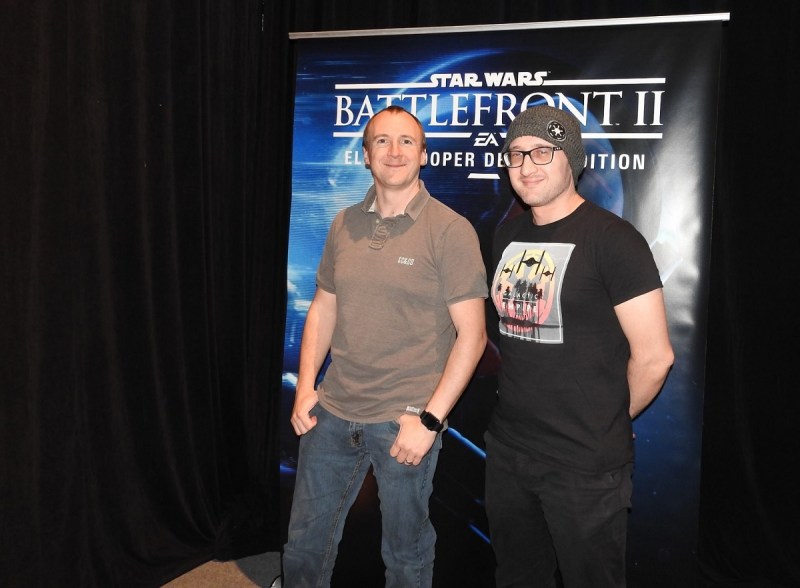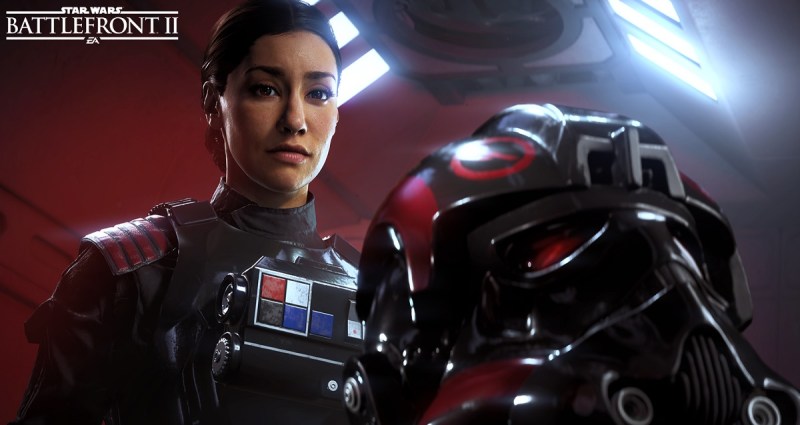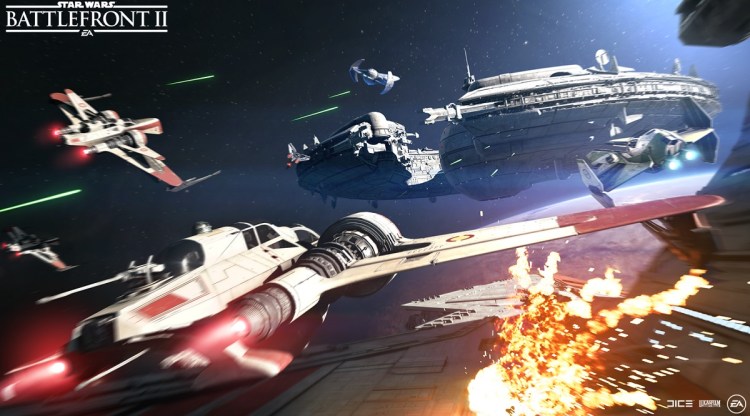Star Wars: Battlefront II debuts on November 17 as one of the biggest video games of the year. One of its hallmarks are bigger and better multiplayer modes compared to the original (multiplayer-only) Star Wars: Battlefront from 2015.
Electronic Arts’ DICE, Criterion, and Motive studios have been working hard on the massive game for the simultaneous launch on the PlayStation 4, Xbox One, and PC. EA showed the full multiplayer mode to us at a review event at EA’s headquarters in Redwood City, California. I played every mode at the event and then interview two of the multiplayer leaders, Paul Keslin, producer at EA DICE, and Pete Lake, producer at Criterion.
They say that Battlefront II’s multiplayer is about the fantasy of being a trooper, pilot, or hero in the Star Wars universe. It mixes all the characters and soldiers from all Star Wars time periods and results in crazy experiences, such as the Heroes vs. Villains mode where four heroes — like Luke Skywalker or Rey — square off against villains like Kylo Ren and Darth Vader. Overall, multiplayer is much deeper with Battlefront II.
The experience starts easy with Arcade mode, which is a solo or co-op experience where you can explore the characters’ capabilities and learn how to play. You can graduate to flying starfighters in Starfighter Assault or take objectives in Strike mode. But I loved the massive 20-versus-20 Galactic Assault mode, where you take multiple objectives from the enemy in a narrated battle. I interviewed Keslin and Lake, and we talked about the design of multiplayer and tips for how to play. This first interview focuses on the design, and the second will deal with the tips. I’ve also embedded a video capture of a Starfighter Assault battle.
Here’s an edited transcript of our interview.

Above: Pete Lake (left), producer at Criterion, and Paul Keslin, producer at DICE, worked on Star Wars: Battlefront II’s multiplayer.
GamesBeat: From a design standpoint, how did you start collaborating on multiplayer and ultimately get to a design?
Paul Keslin: For most of the time, we knew that we always wanted a good partner. We had worked with Criterion on the VR mission for the first Battlefront. They do amazing vehicle work. From a DICE perspective, when we set out to make this game, we wanted to look to some experts that could really lend a great creative eye and design eye to starfighters, in a way that I don’t think we could begin to approach. They’re just so knowledgeable in that area. That’s the start of it.
Pete Lake: It’s been great to come on board and work with DICE on this. We had a good experience before. Something that’s worked well for us it’s not just about sending people from Criterion over the pond to Sweden to work at DICE. It’s about how we divide this game up into ownable pieces. DICE were delivering all the multiplayer on the troopers, and it was our responsibility to deliver great vehicles and new game modes alongside that. We took DICE’s lead on what multiplayer means in Battlefront.
Keslin: It wasn’t just that we threw them something and left it off in a corner until we needed it ourselves. It was constant communication. Pete and I have traveled back and forth to each other’s offices a lot. It’s about how we work together and create something together.
Lake: That crosses all three studios. There’s no element of the game that is isolated. The trooper combat is everywhere in the game, whether it’s in campaign or multiplayer. The starfighter combat is the same whether you’re in campaign or Galactic Assault or Starfighter Assault. We’re trying to make, together, a very consistent experience for the player.
GamesBeat: It seemed like one of the goals was just to make something bigger.
Lake: At a very basic level, yeah. The Star Wars universe is so epic. It means something different to all the different fans of Star Wars. I’m of a classic generation, an older guy, and I grew up with the original trilogy. But you talk to people through this job and you find out that their entry point into Star Wars was the prequels or the Clone Wars TV series. There’s people you meet now who don’t know what an A-Wing is because they’ve never seen the original trilogy. It’s been amazing to work on the scale of this game across the studios to deliver something for everyone.
Keslin: Myself as well, I grew up with the original trilogy, but the prequel trilogy opened the door for so many opportunities for battle-style gameplay. It was really a galaxy at war at that point. There’s a lot of things it gives us the opportunity to pull from. It’s an area we can really open up and explore. But we’ll always start off with things that are familiar to a wide audience, and we’ll continue to grow that over time.

Above: You can play as Iden Versio in multiplayer for Star Wars: Battlefront II.
GamesBeat: Is there some coordination with the single-player side of things as well? Even on the earnings calls, the way it was communicated is that you start with multiplayer first and the single-player experience builds on that.
Keslin: There’s a little truth to that, but it’s more — like I mentioned earlier on, we build a foundation for that through-the-gun experience, what the second-to-second gameplay feels like when you’re playing as a trooper. Then Motive took that and said, “How do we build a campaign around this thing?” As a player, it feels like I’m playing the same game everywhere, even if a different studio worked on it. Every studio lends their own eye to a thing, but we’re all collaboratively working toward the same goal with the same tool sets at our disposal. It’s something that I think came together really well.
Lake: Motive focused on making a very authentic narrative story experience, which is what fans want from a Star Wars campaign. DICE focused on delivering epic multiplayer battles. And then we tried to do the same at Criterion with, how do make everyone feel like an ace fighter pilot?
GamesBeat: As far as accessibility goes, it’s probably one of the most accessible shooters out there. Do you see it as having a distinction from Battlefield in that respect?
Keslin: Pete mentioned earlier that the audience for Star Wars is a bit different. It runs a huge gamut of ages. How do you make something that, depending on your age and skill level, you’re able to jump in and it feels familiar, feels intuitive. You’re able to have fun almost immediately. I’ll let Pete talk to it more, but the team at Criterion did a great thing with Arcade, which allows players to bridge that gap between single-player and multiplayer. Again, it feels similar everywhere.
Lake: Adding split-screen to the console play is huge for accessibility. It’s a cross-generational thing with families, Star Wars. You want to be able to sit there — fathers, sons, daughters, brothers, sisters — and have those competitions. We offer those experiences. Let’s see what happens with Darth Maul faces off against Yoda, or Han and Chewie running through Mos Eisley shooting down Stormtroopers. You can have those moments at any level.
The accessibility is something, from a starfighter point of view, we really tried to push as well. It was there in Battlefront. It was something anybody could pick up and play, flying a starfighter or running around as a trooper. But what players wanted on top of that — they become gamers and they want a little more depth. We’ve added those layers in there, beyond just switches to turn things on and off. You can get used to adding roll to the craft, have a bit more control and nuance to your behavior.
Keslin: With Arcade, we have that opportunity for players to try out a bunch of stuff in a more safe environment. They’re not getting hit really hard by players who’ve played tons of hours of multiplayer. It’s an environment for you to test out different classes and things we’ve provided so you feel comfortable with the controls. You’re familiar with what you’re playing, how each class feels different, how each hero might feel different. It’s a good place for players to learn.

Above: Starfighter combat in Star Wars: Battlefront II.
GamesBeat: As far as making the hardcore folks happy, how do you work on that?
Lake: From a starfighter point of view, we’ve developed a big objective-based game mode, the kind of thing that more core gamers are used to. There’s an attacker side and a defender side and multiple phases. These games can last 20 or 30 minutes.
GamesBeat: More like Battlefield.
Lake: It’s more inspired by what the studios are making in Battlefield, and what it means to have a big narrative-driven — the thing that Star Wars adds is that narrative layer. We’re going to tell a story of the Resistance setting a trap for the First Order and then layers of story within that as you play.
The other areas, more second-to-second, we’re adding those layers of complexity within the controls. We have a class-based system, so you can choose the strategy you’d like, whether you’re in a starfighter or on the ground. Do I want to be in a fighter, more of a multirole ship? Do I want to be dogfighting and really focusing with an interceptor, which is much more agile and can chase things around asteroid fields? Or do I want to play the objectives and get in there with my bomber and blow things up?

Above: Attacking the Imperials on Kashyyyk in Star Wars: Battlefront II’s Galactic Assault mode.
Keslin: With Galactic Assault, we did the same thing. That’s where a lot more of the depth comes in from that strategic layer of gameplay. Players being able to bounce between classes, picking the right tools for the job. Pete mentioned how his fighter class is a good all-rounder, but interceptor is better at taking out other players. It’s similar for our assault class. Each thing has their own role.
Within those roles — and this goes for starfighters as well, for anything you can play in the game — with the addition of star cards for all of these things, you’re able to customize that class, that hero, that vehicle in a way that makes it feel a bit more your own. You can specialize in certain areas, or you can try to be more well-rounded, but still within a role. If you want to be a super tanky heavy class on the ground, you can do that. If you want to be a bit more balanced in your approach, but still fulfill a role of trying to push through barriers of people, the heavy is still the right class. It’s just about how you want to do that. There are different methods. That’s where earning star cards through play will allow you to customize that.

